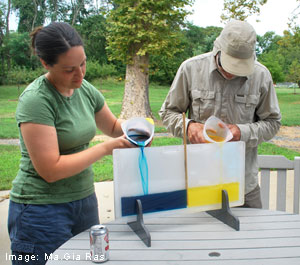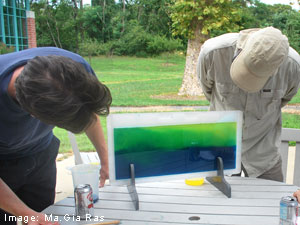Objective
To demonstrate density differences in ocean and coastal waters, and how these differences drive currents.
Background
Circulation in estuaries and oceans depends in part on differences in density of the waters. Water with more salt is heavier and sinks while fresher water is lighter and “floats” on the surface. These buoyancy differences result in the separation of water into layers (stratification) within an estuary or coastal ocean. Stratification can be disrupted by heating and cooling of surface waters and/or by wind-generated water movement like waves and currents. The primary source of fresh water in estuaries and coastal oceans is from rivers coming from land with a rating of 0-5 practical salinity units (PSU), while salt water is from the open oceans and has a rating of 32-35 PSU. In this simulation we will observe what happens when simulated river water is mixed with simulated ocean water.
Materials
- Glass or clear plastic tank (example 10 gallon aquarium) (see instructions for constructing density tank in Lesson Resources)
- Food coloring
- Water
- Salt (kosher salt works best)
- Straw

- Student Worksheet (download below)
Procedure
Part 1
- Measure 1 liter of tap water (to simulate river water) into a beaker or similar vessel. You can add red or yellow dye to this water if you want, or just keep it clear.
- Repeat this step, except to this second beaker, add blue dye and add 10 grams of table salt (to simulate ocean water).
- Set up tank with a divider in the middle. The divider should be cut to fit the width of the aquarium. Use ¼ inch durable plastic or glass.
- Slowly pour the “river” water into one side of the demonstration tank and the "ocean" water to the other side. Fill tank about half full and remove the divider. Observe.
- Record observations (either write down the questions below or download the student worksheet).
Part 2
- Blow on the surface of the water through a straw. A light "breeze" will not have much of an effect; however if you blow hard enough, a constant "wind" will cause the top water to move across the tanks, to be replaced by the bottom water, simulating upwelling.
- Record your observations (follow the questions below or download the student worksheet).
Observations
After adding the fresh and salty water to the tank:
- Which water had a higher density?
- What happened to the two water masses?
After blowing on the surface of the water through a straw:
- What happens to the two layers of water?
- What happens when the wind stops?
- How does this apply to the real world in coastal waters?
Lesson Resources